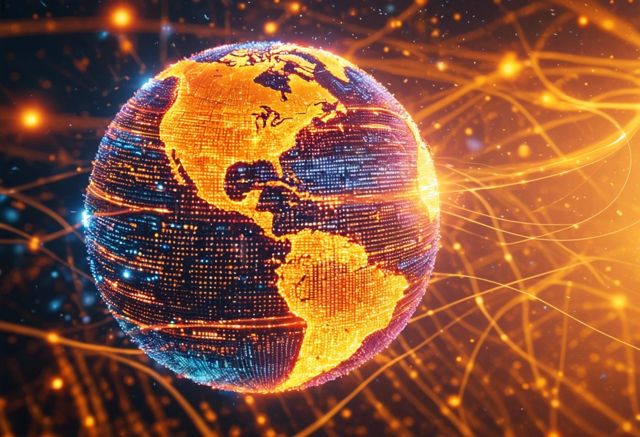Analytics is pivotal in addressing global challenges by enhancing disaster response and climate change mitigation through the effective use of deep learning to process and analyze diverse data types. Continued innovation and collaboration in developing robust models are essential to fully harness this potential and improve global health and economic outcomes.
1. Enhancing Disaster Response Efforts
Analytics has become increasingly critical in optimizing strategies for disaster response. This has involved the large-scale monitoring of real-time data to improve decision-making during crises. Here’s how:
- One of the key advancements has been the use of Deep Learning (DL), mainly in the academic sphere. DL uses various forms of data including images, texts, videos, and audio for disaster management.
- Despite these advancements, there’s still a reliance on textual data, making other data form underutilized.
- DL shows potential in extracting useful information from different data modalities, but challenges exist.
- Challenges include the complexity of integrating and analyzing large-scale multimodal data in real-time. Traditional Machine Learning (ML) models with dependencies on handcrafted features also pose difficulties.
DL could potentially transform disaster response. Here’s how:
- DL requires less manual feature crafting. This makes it potentially crucial for enhancing disaster response tasks by providing an efficient way to process and analyze data.
- However, applying DL in practical disaster response remains a challenge due to issues of model overfitting and underfitting.
- Notably, efforts should be devoted to improving high-quality, annotated training datasets for DL application in disaster scenarios.
- Current research focuses heavily on image-based tasks such as damage assessment, but other critical disaster response tasks are underexplored.
- The advancement of DL in disaster response could lead to more diverse applications, improved data preprocessing methods, and the development of models that can handle different disaster types and datasets.
In conclusion, DL has the potential to redefine disaster response through accurate, timely, and efficient analysis. However, collaborative efforts are needed in the research community to develop innovative DL solutions that can truly benefit disaster management operations.

2. Tackling Climate Change with Data
Data analytics are playing a critical role in solving climate change challenges:
- Data sources include images, texts, videos, and audio which are often underutilized but can contribute valuable insights.
- DL is showing promise in processing and analyzing these different types of data.
However, some challenges and gaps in usage still exist:
- The data quantity is large, and real-time analysis is complex.
- Traditional Machine Learning models still rely heavily on manually crafted features, slowing the response.
Improvements are being made in using DL in climate change scenarios. Several factors are critical to ensure the efficient application of DL:
- The training data quality is key.
- Preprocessing techniques are evolving.
- Overfitting and underfitting of models is a challenge that needs addressing.
A component-based approach is suggested for using DL in climate change:
- Different DL architectures are being examined.
- The importance of high-quality, annotated training datasets is highlighted.
Thus, collaboration is required to enhance DL applications and tackle climate change issues effectively:
- Diversifying the application of DL can drive innovation.
- Improving data preprocessing methods can optimize tasks.
- Developing models that can respond across different data types and datasets can bring broader solutions.
To recap, DL holds great potential to contribute to climate change mitigation by providing more accurate and efficient analysis. Overcoming the highlighted challenges is crucial to fully harness this potential.
3. Improving Global Health Outcomes
Healthcare organizations worldwide are leveraging data analytics to help mitigate global health crises. These efforts often involve tracking disease outbreaks and optimizing resources for the most effective response:
- Analytics play a crucial role in turning large-scale data from various sources into actionable insights. Yet, the current utilization of data analytics in healthcare is mostly academic and has yet to maximize its potential in practical applications.
- Textual data serve as the primary source of information, but there is growing recognition of the value of multimodal data such as images, audio, and videos from social media platforms.
- The application of Deep Learning (DL) shows promise, particularly in image-based tasks like damage assessment from remotely sensed data. However, its deployment is still limited, and its use for other critical tasks needs further exploration.
Despite advances, significant challenges remain:
- Integrating and analyzing large-scale multimodal data in real time is complex and presents a pressing challenge.
- Traditional Machine Learning models, which rely heavily on man-made features, can delay responses due to their labor-intensive nature.
- Overfitting and underfitting of DL models stand as obstacles in providing accurate analysis and predictions.
The academic community is exploring ways to improve the directly applicable use of DL methods:
- The industry recognizes the need for high-quality, annotated training datasets for effective DL.
- Data preprocessing methods need improvement to ensure that DL models can generalize across different types of data.
- Collaboration within the research community is a critical factor in developing practical DL solutions.
Through refined use of analytics, responses to health crises can improve significantly, leading to more swift, accurate, and efficient outcomes. This evolution underscores the transformative potential of DL and data analytics in addressing global health issues.
![]()
4. Boosting Economic Development
Data analytics have provided crucial insights that guide economic policies and interventions globally. Bundled with technology advancements, these data insights are enhancing financial inclusion and predicting economic trends.
In a detailed review by Springer, it was highlighted how the application of Deep Learning (DL) in Disaster Response (DR) was analyzed:
- It showed how information, from diverse data modalities like images, texts, videos, and audio, is extracted.
- The review acknowledged the underutilization of data forms other than text data and the potential to harness them for managing disasters.
- The gap in the practical application of DL in DR was brought into focus, which was predominantly limited to the academic sphere.
Response to disasters can be revolutionized through DataLemon’s tools, effectively analyzing large-scale data in real-time.
Challenges and gaps in DR:
- Difficulty in integrating and analyzing data on a large scale in real time.
- Dependency on traditional Machine Learning (ML) models which impede timely responses.
Addressing these, DL models, which require less manual feature crafting, can add efficiency. This invites the need for addressing tools to enhance response tasks.
Furthermore, the Springer review suggests:
- The need for high-quality, annotated training datasets.
- More diverse applications of DL in DR.
- Improved data preprocessing methods.
- Development of models that can generalize across different disaster types and datasets.
By using advanced tools, we can cultivate mature strategies to fully realize the potential of DL. Concluding thoughts find the potential for joint efforts to develop innovative DL solutions practically deployed in disaster situations, improving the effectiveness of disaster management operations.

SOURCES:
- Springer: Deep Learning in Disaster Response
FAQ
How is analytics enhancing disaster response efforts?
Analytics, particularly through the use of Deep Learning (DL), is optimizing disaster response by enabling large-scale monitoring and analysis of various data types like images, texts, videos, and audio in real time. This improves decision-making during crises by reducing the need for manual feature crafting and allowing for more efficient data processing.
What are the main challenges in applying DL to disaster response?
The main challenges include the complexity of integrating and analyzing large-scale multimodal data in real time, the reliance on traditional Machine Learning models that require manually crafted features, and the issues of model overfitting and underfitting. Additionally, there is a need for high-quality, annotated training datasets to improve the applicability of DL in practical disaster scenarios.
How is data analytics contributing to tackling climate change?
Data analytics, through the use of DL, is critical in addressing climate change challenges, especially in disaster response. DL helps in processing and analyzing diverse data types which can provide valuable insights for climate action. However, overcoming challenges like data volume management, real-time analysis complexity, and improving model accuracy are pivotal for enhancing its effectiveness.
What improvements are suggested for using DL in disaster response related to climate change?
Improvements include diversifying DL applications in disaster response, enhancing data preprocessing methods, and developing models capable of responding to various disaster types and datasets. These advancements can help optimize disaster response tasks and contribute significantly to climate change mitigation efforts.
In what ways are healthcare organizations using data analytics to improve global health outcomes?
Healthcare organizations use data analytics to track disease outbreaks and optimize resource allocation for effective responses. The integration of DL in analyzing multimodal data from sources like social media enhances the ability to assess damages and predict needs more accurately, which is crucial in managing global health crises.
What are the ongoing challenges in integrating data analytics in global health disaster response?
Challenges include the complexity of real-time analysis of large-scale multimodal data, the dependency on traditional ML models that are labor-intensive, and the need for improvements in data preprocessing and model generalization. Addressing these challenges is essential for enhancing the effectiveness and accuracy of disaster responses in global health.
How are economic development efforts supported by data analytics?
Data analytics provide insights that guide economic policies and interventions, enhancing financial inclusion and predicting economic trends. By leveraging technologies like DL, economic development initiatives can benefit from more efficient and timely analysis of diverse data, leading to better-informed decisions and policies.
What role does DL play in boosting economic development through disaster response?
DL facilitates the extraction and analysis of information from diverse data sources, which can revolutionize disaster response by improving efficiency and reducing the reliance on manually crafted features. This can lead to more effective interventions and better resource management in economic development contexts.




